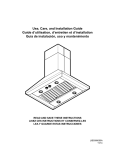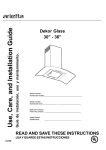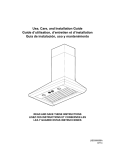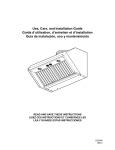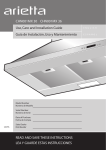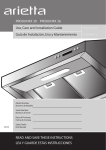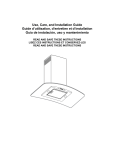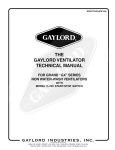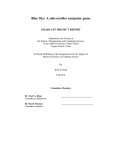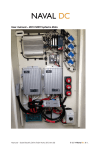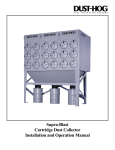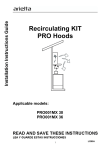Download Arietta ALS436SS Instructions / Assembly
Transcript
Guía de Instrucciones para Instalación Installation Instructions Guide READ AND SAVE THESE INSTRUCTIONS LEA Y GUARDE ESTAS INSTRUCCIONES English Español page página 2 12 LIB0102593 Table of Contents APPROVED FOR RESIDENTIAL APPLIANCES FOR RESIDENTIAL USE ONLY Important Safety Notice ..........................................................2 Tools and parts ........................................................................3 Location Requirements ......................................................3 Product Dimensions ...........................................................3 Electrical Requirements .....................................................4 Venting Requirements ........................................................4 Venting Methods ................................................................4 Installation Instructions ..........................................................5 Electrical Connection...............................................................6 Hood Description......................................................................8 Controls...............................................................................8 Range Hood Care......................................................................9 Grease filter..........................................................................9 Replacing the light bulb........................................................10 Warranty.....................................................................................11 READ AND SAVE THESE INSTRUCTIONS PLEASE READ ENTIRE INSTRUCTIONS BEFORE PROCEEDING. INSTALLATION MUST COMPLY WITH ALL LOCAL CODES. IMPORTANT: Save these Instructions for the Local Electrical Inspector’s use. INSTALLER: Please leave these Instructions with this unit for the owner. OWNER:Please retain these instructions for future reference. Safety Warning:Turn off power circuit at service panel and lock out panel before wiring this appliance. Requirement 120 VAC, 60 Hz. 15 or 20 A Branch Circuit IMPORTANT SAFETY INSTRUCTIONS WARNING: TO REDUCE THE RISK OF FIRE, ELECTRIC SHOCK, OR INJURY TO PERSONS, OBSERVE THE FOLLOWING: WARNING: TO REDUCE THE RISK OF A RANGE TOP GREASE FIRE: ■■ Never leave surface units unattended at high settings. Boilovers cause smoking and greasy spillovers that may ignite. Heat oils slowly on low or medium settings. ■■ Always turn hood ON when cooking at high heat or when flambeing food (i.e. Crepes Suzette, Cherries Jubilee, Peppercorn Beef Flambé). ■■ Clean ventilating fans frequently. Grease should not be allowed to accumulate on fan or filter. ■■ Use proper pan size. Always use cookware appropriate for the size of the surface element. WARNING: TO REDUCE THE RISK OF INJURY TO PERSONS IN THE EVENT OF A RANGE TOP GREASE FIRE, OBSERVE THE FOLLOWING:a ■■ SMOTHER FLAMES with a close fitting lid, cookie sheet, or metal tray, then turn off the burner. BE CAREFUL TO PREVENT BURNS. If the flames do not go out immediately, EVACUATE AND CALL THE FIRE DEPARTMENT. ■■ NEVER PICK UP A FLAMING PAN - you may get burned. ■■ DO NOT USE WATER, including wet dishcloths or towels a violent steam explosion will result. ■■ Use an extinguisher ONLY if: -You know you have a class ABC extinguisher, and you already know how to operate it. – The fire is small and contained in the area where it started. – The fire department is being called. – You can fight the fire with your back to an exit. ■■ Use this unit only in the manner intended by the manufacturer. If you have questions, contact the manufacturer. ■■ Before servicing or cleaning the unit, switch power off at service panel and lock the service disconnecting means to prevent power from being switched on accidentally. When the service disconnecting means cannot be locked, securely fasten a prominent warning device, such as a tag to the service panel. ■■ Installation work and electrical wiring must be done by qualified person(s) in accordance with all applicable codes and standards, including fire-rated construction. ■■ Sufficient air is needed for proper combustion and exhausting of gases through the flue (chimney) of fuel burning equipment to prevent backdrafting. Follow the heating equipment manufacturer’s guideline and safety standards such as those published by the National Fire Protection Association (NFPA), the American Society for Heating, Refrigeration and Air Conditioning Engineers (ASHRAE), and the local code authorities. ■■ When cutting or drilling into wall or ceiling; do not damage electrical wiring and other hidden utilities. ■■ Ducted fans must always be vented outdoors. CAUTION: For general ventilating use only. Do not use to exhaust hazardous or explosive materials and vapors. CAUTION: To reduce risk of fire and to properly exhaust air, be sure to duct air outside - do not vent exhaust air into spaces within walls or ceilings, attics or into crawl spaces, or garages. Based on “Kitchen Fire Safety Tips” published by NFPA. WARNING: To reduce the risk of fire or electrical shock, do not use this fan with any solid-state speed control device. a WARNING: TO REDUCE THE RISK OF FIRE, USE ONLY METAL DUCTWORK READ AND SAVE THESE INSTRUCTIONS 2 Tools and Parts Gather the required tools and parts before starting installation. Read and follow the instructions provided with any tools listed here. CAUTION: Remove carton carefully, Wear gloves to protect against sharp edges. Location Requirements IMPORTANT: Observe all governing codes and ordinances. Have a qualified technician install the range hood. It is the installer’s responsibility to comply with installation clearances specified on the model/serial rating plate. The model/serial rating plate is located behind the left filter on the rear wall of the vent hood. Canopy hood location should be away from strong draft areas, such as windows, doors and strong heating vents. Cabinet opening dimensions that are shown must be used. Given dimensions provide minimum clearance. Grounded electrical outlet is required. See “Electrical Requirements” section. The canopy hood is factory set for venting through the roof or wall. For non-vented (recirculating) installation, the KIT01937 must be purchased with your provider. Tools needed (all models) ■■ Wire nuts ■■ Metal duct lenght to suit installation ■■ ⁄2 ” Romex wire connector 1 ■■ 6” rounded metal duct lenght to suit installation ■■ Measuring tape ■■ Pliers ■■ Gloves ■■ Knife For Mobile Home Installations The installation of this range hood must conform to the Manufactured Home Construction Safety Standards, Title 24 CFR, Part 328 (formerly the Federal Standard for Mobile Home Construction and Safety, Title 24, HUD, Part 280) or when such standard is not applicable, the standard for Manufactured Home Installation 1982 (Manufactured Home Sites, Communities and Setups) ANSI A225.1/NFPA 501A, or latest edition, or with local codes. ■■ Safety glasses ■■ Electric drill with 5⁄16” and 3⁄8” Bits ■■ Spirit level ■■ Duct tape ■■ Screwdrivers: ■■Philips (Posidrive #2) ■■Torx #2 ■■ Wire cutter/ stripper Product Dimensions ■■ Masking tape 103⁄4” (27.3 cm) ■■ Hammer 6” (15.24 cm) ■■ Saw, jigsaw or reciprocating saw Parts Supplied Remove parts from packages. Check that all parts are included. ■■ Hood canopy assembly with blower. 133⁄16” (33.5 cm) ■■ Lamps already installed. ■■ Air transition Ductless (recirculating) version only *Max 429⁄16” (108 cm) *Min 284⁄16” (71.7 cm) ■■ Grease filter ■■ Duct covers ■■ Hardware package. Includes: • • • • • • • • • Ducted version only *Max 3814⁄16” (98.76 cm) *Min 249⁄16” (62.4 cm) Template Duct cover support bracket (1 piece) Use, care and installation guide Wood screws (6 pieces- 5 x 45 mm) Concrete wall anchors (6 pieces- 8 x 40 mm) Assembly screws (4 pieces - 4.2 x 8 mm) Air transition screws (2 pieces - 3.5 x 9.5 mm) TORX 10 adapter TORX 20 adapter 5” (12.6 cm) 30” (76.2 cm) or 36” (91.4 cm) Optional Accesories ■■ Recirculation KIT (KIT01937). †®TORX is a registered trademark of Saturn Fasteners, Inc. 3 1911⁄16” (50 cm) Electrical Requirements Makeup air Local building codes may require the use of makeup air systems when using ventilation systems with greater than specified CFM of air movement. The specified CFM varies from locale to locale. Consult your HVAC professional for specific requirements in your area. IMPORTANT: The range hood must be electrically grounded in accordance with local codes and ordinances, or in the absence of local codes, with the National Electrical Code, ANSI/NFPA 70 (latest edition) or Canadian Electrical Code, CSA C22.1 No. 0-M91 (latest edition). If codes permit and a separate ground wire is used, it is recommended that a qualified electrical installer determine that the ground path is adequate. A copy of the above code standards can be obtained from: National Fire Protection Association 1 Batterymarch Park Quincy, MA 02169-7471 CSA International 8501 East Pleasant Valley Road Cleveland, Ohio 44131-5575 ■■ A 120 volt, 60 Hz, AC only, 15- or 20-amp, fused electrical circuit is required. A time-delay fuse or circuit breaker is also recommended. It is recommended that a separate circuit serving only this range hood be provided. ■■ Venting Methods This canopy range hood is factory set for venting through the roof or through the wall. A 6” (15.2 cm) round vent system is needed for installation (not included). The hood exhaust opening is 6” (15.2 cm) round. NOTE: Flexible vent is not recommended. Flexible vent creates back pressure and air turbulence that greatly reduce performance. Vent system can terminate either through the roof or wall. To vent through the wall, a 90° elbow is needed. Rear Discharge A 90° elbow may be installed immediately above the hood. For Non-Vented (Recirculating) Installations If it is not possible to vent cooking fumes and vapors to the outside, the hood can be used in the non-vented (recirculating) version, using a Recirculation Kit (which includes charcoal filters and a deflector). To order, see the “Optional Accesories” section. To minimize possible shock hazard, the cord must be plugged into a mating, 3 prong, grounding-type outlet, grounded in accordance with local codes and ordinances. If a mating outlet is not available, it is the personal responsibility and obligation of the customer to have the properly grounded outlet installed by a qualified electrician. Exit through the roof Exit through the wall Recirculating A A B VENTING REQUIREMENTS B ■■ Vent system must terminate to the outdoors. C C B A C ■■ Do not terminate the vent system in an attic or other enclosed area. ■■ Do not use a 4” (10.2 cm) laundry-type wall caps. ■■ Use metal vent only. A rigid metal vent is recommended. Plastic or metal foil vent is not recommended. ■■ The length of the vent system and number of elbows should be kept to a minimum to provide efficient performance. For the most efficient and quiet operation: ■■ Use no more than three 90° elbows. A. Roof cap B. Duct C. Transition ■■ Make sure there is a minimum of 24” (61.0 cm) of straight vent between the elbows if more than 1 elbow is used. A. Wall cap B. 90° Elbow C. Transition A. Air deflector B. Duct C. Transition Preparation Do not cut a joist or stud unless absolutely necessary. If a joist or stud must be cut, then a supporting frame must be constructed. Fittings material is provided to secure the hood to most types of walls/ceilings. However, a qualified technician must verify suitability of the materials in accordance with the type of wall/ceiling. Before making cutouts, make sure there is proper clearance within the ceiling or wall for exhaust vent. Hood installation height above cooktop is the users preference. The lower the hood is above the cooktop, the more efficient the capturing of cooking odors, grease and smoke. ■■ Do not install 2 elbows together. ■■ Use clamps to seal all joints in the vent system and use furnace duct tape to fully seal joint connection. ■■ Use caulking to seal exterior wall or roof opening around the cap. ■■ The size of the vent should be uniform. Cold weather installations An additional back draft damper should be installed to minimize backward cold air flow and a thermal break should be installed to minimize conduction of outside temperatures as part of the vent system. The damper should be on the cold air side of the thermal break. The break should be as close as possible to where the vent system enters the heated portion of the house. Set the hood’s mounting height based on the next recommendations: ■■ Minimum distance “X”: 24” (61.0 cm) from electric cooking surface. ■■ Minimum distance “X”: 30” (76.2 cm) from gas cooking surfaces. ■■ Suggested maximum distance “X”: 36” (91.4 cm). 4 Installation Instructions Duckwork and wiring locations Wall ducting ■■ Determine the exact location of the vent hood. If ductwork will vent to rear: ■■ Locate the template packed with the literature. ■■ Use a level to draw a line straight up from the centerline on the template. ■■ Installation height: 30” electric cooktop/range or 24” to 30” electric cooktop/range. ■■ ■■ Use a level to draw a horizontal straight pencil line on the wall, wich is your desired installation height. ■■ Find the centerline of the cooktop. Use a level to draw a vertical straight pencil line on the wall. Measure at least 233⁄4”(The measure might vary depending on the elbow used) above the pencil line that indicates the bottom installation height, to the circle center of an 61⁄2” diameter duct hole (Hole may be elongated for duct elbow). House wiring location ■■ The junction box is located on the top left side of the hood. ■■ Wiring should enter the back wall at least 20” above the bottom of the instalation height, and within 57⁄8” and 47⁄8” of the left side of the centerline. CHECK TO BE SURE THE LINE IS PERFECTLY PERPENDICULAR. Mounting the duct cover bracket For ceiling vent ducting 43⁄4” circle center to wall The duct cover bracket should be installed against the back wall and flush with the ceiling. This bracket will hold the duct cover in place at the top. Ceiling 61⁄2” dia.hole Secure the bracket to the wall: ■■ Align the marked centerline on the bracket with the centerline on the wall. Circle center at 233⁄4” above the marked bottom pencil line For wall vent duct ■■ Mark 2 screws hole locations in the wall. ■■ Drill 5⁄16” pilot holes in the marked locations. ■■ Install wall fastener anchors. ■■ Drive wood screws, by hand, into the fastener to allow anchors to expand. Remove the screws. ■■ Secure the bracked to the wall with wood screws and/or fasteners. Horizontal straight pencil line Install framing for hood support ■■ If drywall is present, mark the screw hole locations. Remove the template. ■■ Cut away enough drywall to expose 2 vertical studs at the holes location indicated by the template. ■■ Install two horizontal supports at least 1”x6” between two wall studs at the bottom and top mounting holes installation location. ■■ The horizontal support must be flush with the room side of the studs. Use cleats behind both sides of the support to secure to wall studs. ■■ Reinstall drywall and refinish. IMPORTANT: Framing must be capable of supporting 100 lbs. 61⁄2 minimum opening for ductwork Cleats view from rear Ceiling ducting 1˝ x 6˝ minimum mounting support If the duct will vent straight up to the ceiling: ■■ Use level to draw a line straight up, from the centerline on the template to the ceiling. ■■ Measure at least 43⁄4” from the back wall to the circle center of an 61⁄2” hole on the ceiling. Centerline of installation space 5 Mounting the hood 1. Install transition on top of hood (if removed for shipping) with ■■ Mark “lower” wood screw holes locations in wall using a pencil. 2 - 3.5 x 9.5 mm sheet metal screws. B A ■■ Remove the hood. ■■ Drive the “lower” wood screws, by hand. Remove screws. ■■ Mount the hood onto the “upper” wood screws, by hand. ■■ Drive and tighten the “lower” wood screws, by hand. A A. Vent transition B. 3.5 x 9.5 mm screw B WARNING A 2 people are required to lift and position the hood onto the mounting screws. A. 5 x 45 mm screw B. Mounting slots Electrical Connection ■■ Place the template on the wall along the horizontal line, make sure the template is leveled and centered with the centerline. ■■ Mark “upper” screw holes locations in the wall IMPORTANT: Check to be sure that hole locations are leveled and correctly centered bye the vertical centerline. WARNING ■■ Drive “upper” wood screws by hand. Leave ¼” of distance between the screw head and the wall. ¼˝ (6.4mm) Electrical Shock Hazard Warning: Turn off the power circuit at the service panel before wiring this unit. 120 VAC, 15 or 20 Amp circuit required. ■■ Remove the grease filter and mount the hood onto the “upper screws”. ELECTRICAL GROUNDING INSTRUCTIONS THIS APPLIANCE IS FITTED WITH AN ELECTRICAL JUNCTION BOX WITH 3 WIRES, ONE OF WHICH (GREEN/YELLOW) SERVES TO GROUND THE APPLIANCE. TO PROTECT YOU AGAINST ELECTRIC SHOCK, THE GREEN AND YELLOW WIRE MUST BE CONNECTED TO THE GROUNDING WIRE IN YOUR HOME ELECTRICAL SYSTEM, AND IT MUST UNDER NO CIRCUMSTANCES BE CUT OR REMOVED. Failure to do so can result in death or electrical shock. 6 ■■ Remove the knockout and the Junction box cover and install the conduit connector (cULus listed) in junction box. Mounting the duct cover ■■ Position the duct cover over the mounted hood. ■■ Slide the bottom of the duct into the glass area. ■■ Position the top of the duct over the duct mounting bracket. If a telescopic duct cover is used, grab the upper part of the telescopic duct cover, pull it and place it in the duct cover mounting bracket. ■■ Secure the top of the duct with 2 assembly screws provided. ■■ If not already done, install 1⁄2” conduit connector in j-box. NOTE: This connector is not included with vent hood. ■■ Run black (live), white (neutral), and green (earth) wires (#14 AWG) according to the National Electrical Code or CSA Standards and local codes and ordinances in 1⁄2” conduit from power supply to j-box. ■■ Secure the bottom of the duct with 2 assembly screws provided. ■■ Connect black, white, and green wires from power supply to black, white, and green/yellow wires in j-box respectively. ■■ These connections should be done while always making reference to the electrical diagram found inside the hood. ■■ Close j-box cover and reapply. If range hood does not operate: ■■ Check that the circuit breaker is not tripped or the house fuse blown. ■■ Disconnect power supply. ■■ Check that wiring is correct. ■■ Install the grease filter and turn power on at service panel. Keep your Installation Instructions and Use and Care Guide close to range hood for easy reference. ■■ Check operation of the hood. 7 Description of the hood 1. 2. 3. 4. 5. 6. 7. 3. Display ■■ Shows the hood settings. Blower and light controls Lamp housings Grease filter handle Grease filter Canopy Duct covers Recirculating grid 4. “-” Key. Speed Decrease / OFF ■■ This key is used to decrease the fan speed, or turn OFF the fan. ■■ The fan will turn OFF if the “-” key is pressed and the hood was in the first speed. ■■ If the fan is at second speed and the “-” key is pressed, the fan will be set to first speed. ■■ If the fan is at third speed and the “-” key is pressed, the fan will be set to second speed. ■■ If the fan is OFF and the “-” key is pressed, the control backlight will light up. 5. “+” Key. Speed Increase / ON ■■ This key is used to increase the fan speed, or turn ON the fan. ■■ The fan will turn ON if the “+” key is pressed and the hood was OFF. ■■ If the fan is at first speed and the “+” key is pressed, the fan will be set to second speed. ■■ If the fan is at second speed and the “+” key is pressed, the fan will be set to third speed. ■■ If the fan is at third speed and the “+” key is pressed, a beep will sound. Special functions Clock programming ■■ The clock can be reprogrammed at any time except during an active timed function. Controls ■■ The clock can be displayed in a twelve hour format and valid clock times are from 1:00 to 12:59. This hood is equipped with an electronic motor and lamp control. The control is able to set 3 different fan speeds, turn ON/OFF light and has a timer function. In the following drawing are described the main key functions. ■■ The clock can be reprogrammed pressing the “Timer” key for 5 seconds, and after, the clock can be adjusted with the “+” and “-” keys. Colon “:” will flash indicating clock programming mode. 12 ■■ 3 ■■ The user can finish on reprogramming the clock pressing the “timer” key. 1. Timer Key ■■ The default timer setting is 10 minutes, and it can be adjusted between 20 minutes and 1 minute. ■■ The user can have minute increments / decrements of 1 minute, but if the user keep pressing the “+”/”-” keys for more than 1 second, the increments / decrements will be of 5 minutes. During this option the control will round to the nearest 5 minutes. ■■ After 1 minute of no key pressed the control will accept the programmed clock time and will add one minute to the set clock. After pressing the timer key, the control enters to a timer setup mode, and user can adjust the timer countdown time with the “-” and “+” keys within 5 seconds. The timer can be initiated immediately pressing the timer key, after setting the timer duration or pressing the timer key twice (default 10 minutes setting). Grease filter saturation alarm ■■ After thirty fan functional hours, the display will show “Grease Filter” if the fan is active. When this icon is shown in the display, the grease filters installed are required to be washed. ■■ If not action occurs within 5 seconds the countdown will start. ■■ To reset the grease filter saturation alarm the user must press the “+” key for 5 seconds, after this action the icon “grease filter” is not display, and the hood has the normal display operation. ■■ During the timer setup the “-” and “+” keys are dedicated to the timer and no motor action will occur. ■■ Once initiated the timer, it can be cancelled by pressing the timer key again. 2. Light Key ■■ Press lamp key to turn ON the light (Lamp state previously OFF). ■■ Press lamp key to turn OFF the light (Lamp state previously ON). 8 Charcoal filter saturation alarm (Recirculating accessories) ■■ After one hundred and twenty functional hours of the fan, the display will show “Charcoal Filter” if the fan is active. Range Hood Care ■■ When this icon flashes on display, the charcoal filters installed are required to be replaced or reactivated. The efficiency of the range hood system depends on the cleanliness of the intake and filters. ■■ The frecuency of cleaning depends on the amount and type of cooking. To reset the grease filter saturation indication the user must press the “-” key for 5 seconds, after this time the icon “charcoal filter” is not display and the hood has the normal display operation. ■■ Do not use the ventilating system without the filters in place or with grease-laden filters or surfaces. WARNING Audible signal activation and deactivation ■■ The audible signals can be activated or deactivated pressing the “Light” key for 5 seconds. ■■ If the audible signal is activated, a tone must sound and the “Snd” symbol must appear on the display for 2 second. ■■ If the audible signal is deactivated, the “Snd” symbol must appear on the display for 2 second and no sound must sound. To avoid risk of fire and explotion do not use flammable liquids or solvents. Charcoal filter inclusion and exclusion (Recirculating accessories) ■■ The charcoal filter inclusion or exclusion can be set by pressing the “-” and “+” keys at the same time for 5 seconds. Always unplug or disconnect the appliance from the power supply before servicing. WARNING ■■ The Inclusion or exclusion of charcoal filter must be selected while the lamps and the motor are OFF. ■■ When the charcoal has been excluded, the charcoal filter alarm is disabled. Be sure the entire hood including the filters and light bulbs has cooled and grease has solidified before attempting to clean any part of the appliance. Filters The metal grease filters are made of stainless steel anodized aluminum and are long lasting. To Remove The Metal Grease Filters ■■ Turn the fan and lights off. ■■ Pull the spring release handle. 9 Hood Surface Replacing the halogen lamp CAUTION: Before replacing the lamps, disconnect power off to prevent from being switched on accidentally. Turn off the range hood and allow the halogen / incandescent lamp to cool. To avoid damage or decreasing the life of the new bulb, do not touch bulb with bare fingers. Replace bulb, using tissue or wearing cotton gloves to handle bulb. If new lamps do not operate, make sure the lamps are inserted correctly before calling service. Stainless Steel Surfaces: Wipe and dry stainless steel in the same direction as the grain. Avoid using too much pressure, which may mar the surface. To remove finger prints and give added shine, use cleaners such as Stainless Steel Magic. Do not allow any cleaning compounds to remain in contact with stainless steel for extended periods. Plastic Surfaces: Wipe with a moist soapy sponge. Rinse and dry. ■■ Disconnect power. ■■ Use a flat-blade screwdriver and gently pry the light cover loose. ■■ Remove the lamp and replace with a 120-volt, 40-watt maximum, halogen lamp made for a G-9 base. Aluminum Mesh Filters: Clean filters in the dishwasher or by agitating in sudsy water. Ensure that there is no soil trapped in the fine mesh. Dry the filters before reinstalling them. Optional Recirculating Kit ■■ ■■ ■■ ■■ ■■ ■■ Replace the light cover. ■■ Reconnect power. If the model is not vented to the outside, the air will be recirculated through disposable charcoal filters that help remove smoke and odors. The charcoal filters cannot be cleaned. They must be replaced. The charcoal filters are clipped inside of each metal grease filter (mounting instructions included with recirculating kit mod. KIT01937). The charcoal filters should be replaced every 4-6 months (depending on hood usage). NOTE: DO NOT rinse, or put charcoal filters in an automatic dishwasher. Cleaning ■■ Always use the mildest cleaner that will do the job. Use clean, soft cloths, sponges or paper towels. ■■ Rub stainless steel finishes in the direction of the grain. Wipe area dry to avoid water marks. ■■ After cleaning, place all parts in their proper positons before using. ■■ The cleaners recommended below indicate a type and do not constitute an endorsement. Use all products according to package directions. 10 WARRANTY TO OBTAIN SERVICE UNDER WARRANTY: or any Service Related Questions, please call: 1-888-732-8018 Staple your receipt here. Proof of the original purchase date is needed to obtain service under the warranty. TO OBTAIN SERVICE UNDER WARRANTY: You must present proof of original purchase date. Please keep a copy of your dated proof of purchase (sales slip) in order to obtain service under warranty. Parts and Service Warranty: For the period of one year from the date of the original purchase, we will provide free of charge, non consumable parts or components that failed due to manufacturing defects. During this one year limited warranty, we will also provide, free of charge, all labor and in-home service to replace the defective part. What is Not Covered: ■■ Damage to the product caused by floods, act of God, fire and accidents. ■■ Damage caused after delivery. ■■ House fuses replacement or resetting of circuit breakers. ■■ Service trips to your home to teach you how to use or install the product. ■■ Light bulbs, metal, carbon filters and the other consumable parts. ■■ The natural wear of finish, and wear due to improper maintenance, use of corrosive and abrasive cleaning products, pads, and oven cleaner products. This warranty will be voided when: ■■ Product damaged due to improper installation and failure to follow installation instructions, delivery or maintenance. ■■ Incidental or consequential damage caused by possible defects with this appliance. ■■ Alteration or modification of the Product which may cause in damage to the Product, or failure to operate it in accordance with specifications. ■■ Damage because of improper connection with equipment of other manufacturers. ■■ Failure of the product if it is negligence, abused, misused, or used for other than the intended purpose or used commercially. ■■ Improper repair, modification or servicing of the Product performed by third parties other than Authorized Agents. Who is Covered: This warranty is extended to the original purchaser for products purchased for ordinary home use in the 48 mainland states, Hawaii, Washington D.C. Alaska, Guam, Puerto Rico and the Virgin Islands. This warranty is non-transferable and applies only to the original purchaser and does not extend to subsequent owners of this product. This warranty is made expressly in lieu of all other warranties, expressed or implied, including, but not limited, any implied warranty of merchantability or fitness for a particular purpose, and all other obligations on the part of Elicamex, provided, however, that if the disclaimer of implied warranties is ineffective under applicable law, the duration of any implied warranties arising by operation of law shall be limited to 1 (one) year from the date of original purchase at retail or such longer period as may be required by applicable law. This warranty does not cover any special, incidental and/or consequential damages, nor loss of profits, suffered by the original purchaser, its customers and/or the users of the Product. Have your product proof of purchase with date ready for warranty issues. Or write to: Elicamex Av. La Noria #102 Parque Industrial Querétaro KM 28.5 Carretera Querétaro- San Luis Potosí C.P 76220 México 11 ÍNDICE APROBADO PARA APARATOS DE USO DOMÉSTICO SÓLO PARA USO DOMÉSTICO LEA Y GUARDE ESTAS INSTRUCCIONES Instrucciones de Seguridad Importantes ..............................12 Lista de Materiales....................................................................13 Requisitos de ubicación.......................................................13 Dimensiones del producto...................................................13 Requisitos eléctricos............................................................14 Requisitos de ventilación.....................................................14 Métodos de ventilación........................................................14 Instrucciones de instalación....................................................15 Conexión eléctrica....................................................................16 Descripción de la campana......................................................18 Controles..............................................................................18 Limpieza y cuidado de la campana.........................................19 Filtro contra la grasa............................................................19 Reemplazar las luces..........................................................20 Garantía.....................................................................................21 ANTES DE CONTINUAR, LEA LAS INSTRUCCIONES POR COMPLETO. LA INSTALACIÓN DEBE CUMPLIR TODA LA NORMATIVA LOCAL. IMPORTANTE: Guarde estas instrucciones para su uso por parte del inspector de electricidad local. INSTALADOR: Entregue al propietario estas instrucciones junto con la unidad. PROPIETARIO: Conserve estas instrucciones para futuras consultas. Advertencia de seguridad: Antes de realizar el cableado de este aparato, desactive el circuito de energía eléctrica en el panel de servicio y desbloquee el panel. Requisito: Circuito auxiliar de CA de 120 V, 60 Hz, 15 ó 20 A INSTRUCCIONES IMPORTANTES DE SEGURIDAD ■■ Use esta unidad sólo de la manera para la que fue diseñada por el fabricante. Si tiene preguntas, póngase en contacto con el fabricante. ■■ Antes de dar servicio o limpiar esta unidad, apague el suministro de energía en el panel de servicio, y bloquee los medios de desconexión del servicio para evitar que se encienda accidentalmente el suministro de energía. Cuando el medio de desconexión del servicio no se pueda bloquear, sujete de manera segura un dispositivo de advertencia prominente, como podría ser una etiqueta, al panel de servicio. ■■ El trabajo de instalación y cableado se debe llevar a cabo por una persona(s) calificada(s), en conformidad con todos los códigos y estándares aplicables, incluyendo construcciones clasificadas como resistentes al fuego. ■■ No opere ningún ventilador que tenga un cable o enchufe dañado. Deshágase del ventilador o devuélvalo a un lugar de servicio autorizado para que sea examinado y/o reparado. ■■ Es necesario que haya suficiente aire para la adecuada combustión y ventilación de gases a través del conducto (la chimenea) del equipo que consume combustible, para evitar que ocurra contratiro. Siga la guía y los estándares de seguridad del fabricante del equipo de calefacción, como serían aquéllos publicados por National Fire Protection Association (NFPA) (Asociación nacional de protección contra incendios), American Society for Heating, Refrigeration and Air Conditioning Engineers (ASHRAE) (Sociedad estadounidense para ingenieros de calefacción, refrigeración y acondicionamiento de aire) y las autoridades de códigos locales. ■■ Cuando corte o taladre en una pared o techo, no dañe el cableado ni otros servicios públicos ocultos. ■■ Los ventiladores con conductos siempre deben dar salida al aire hacia el exterior. CUIDADO: Para usarse solamente en ventilación común. No lo utilice para ventilar materiales y vapores peligrosos o explosivos. CUIDADO: Para reducir el riesgo de incendio y para ventilar el aire adecuadamente, asegúrese de dirigir el conducto de ventilación hacia el exterior - no ventile el aire de salida a espacios dentro de paredes o techos, áticos, espacios angostos o garajes. ADVERTENCIA: PARA REDUCIR EL RIESGO DE INCENDIO, SÓLO USE CONDUCTOS METÁLICOS. 12 ADVERTENCIA: PARA REDUCIR EL RIESGO DE INCENDIO PROVOCADO POR GRASA EN LA SUPERFICIE DE LA ESTUFA: ■■ Nunca deje las unidades de superficie sin vigilancia cuando estén en ajustes altos. Los derrames por hervor causan salpicaduras grasosas y humeantes, las cuales pueden encenderse. Caliente los aceites lentamente y con ajustes bajos o medios. ■■ Siempre ENCIENDA la campana cuando cocine con calor alto o cuando flamee alimentos (por ejemplo, crepes Suzette, cerezas Jubileo y flameado de carne de res con pimienta). ■■ Limpie los ventiladores con frecuencia. No permita que se acumule la grasa en el ventilador o en el filtro. ■■ Use cacerolas del tamaño adecuado. Siempre use utensilios de cocción que sean los adecuados para el tamaño del elemento de la superficie. ADVERTENCIA: PARA REDUCIR EL RIESGO DE LESIONES A PERSONAS SI SE PRENDE FUEGO EN LA SUPERFICIE DE LA ESTUFA OCASIONADO POR GRASA, OBSERVE LO SIGUIENTE:a ■■ EXTINGA LAS LLAMAS con una tapa que encaje muy bien, una bandeja para galletas o una bandeja metálica, y luego apague el quemador. TENGA CUIDADO PARA EVITAR QUEMADURAS. Si las llamas no se extinguen de inmediato, EVACUE Y LLAME AL DEPARTAMENTO DE BOMBEROS. ■■ NUNCA AGARRE UNA CACEROLA QUE ESTÉ ARDIENDO - podría quemarse. ■■ NO UTILICE AGUA ni artículos de limpieza con agua, incluyendo paños para vajilla o toallas mojadas - podría ocurrir una explosión de vapor violenta. ■■ SÓLO use un extinguidor si: – Sabe a ciencia cierta que tiene un extinguidor de clase ABC y ya sabe cómo utilizarlo. – El incendio es pequeño y se encuentra contenido en el lugar en donde se inició. – Ha llamado al departamento de bomberos. – Puede apagar el fuego con una salida a su espalda. a Basado en “Consejos de seguridad para fuegos de cocina”, publicado por la NFPA (Asociación nacional de protección contra incendios). ADVERTENCIA: A fin de reducir el riesgo de incendio o de choque eléctrico, no use este ventilador con ningún dispositivo semiconductor para el control de la velocidad. Lista de Materiales ¡PRECAUCIÓN! Quite la caja cuidadosamente, use guantes para protegerse contra los bordes afilados. Requisitos de ubicación IMPORTANTE: Observe todos los códigos y ordenanzas aplicables. Deje que un técnico calificado instale la campana. Es responsabilidad del instalador cumplir con las especificaciones de instalación que vienen en la etiqueta de modelo y número serial. La etiqueta de modelo/número serial está localizada detrás del filtro izquierdo en la pared posterior de la campana. La campana debe estar ubicada lejos de áreas con fuertes corrientes de aire como ventanas, puertas y ductos de ventilación. Una toma de tierra eléctrica es requerida. Vea la sección “Requisitos eléctricos”. Todas las aberturas en el techo y pared donde se ponga en contacto la campana deben de ser selladas. Esta campana está configurada para expulsar el aire através de la pared o el techo. Para convertir a su versión recirculante, considere la adquisición del KIT01937 con su proveedor. Reúna las herramientas y piezas necesarias antes de comenzar la instalación. Lea y siga las instrucciones provistas con cualquiera de las herramientas detalladas aquí. Herramientas requeridas ■■ Tapones de cable ■■ Ducto metálico de 6” ■■ Conector romex de 1⁄2” ■■ Cinta métrica ■■ Cutter ■■ Pinzas para cortar y pelar cable ■■ Nivel Para la instalación en casas rodantes La instalación de esta campana debe hacerse conforme a los Estándares de Seguridad de la Construcción del Hogar, Título 24 CFR, Parte 328 (antes el Standard Federal para la Construcción y Seguridad de Casas Móviles) o cuando el standard no sea aplicable al Standard para la Instalación de Casas Manufacturadas 1982 (Casas, manufacturación de casas e Instalación) ANSI A225.1/NFPA 501A, o última edición, o códigos locales. ■■ Alicates ■■ Cinta de aislar ■■ Lentes de seguridad ■■ Destornilladores: ■■Phillips (Posidrive) #2 ■■Torx #2 ■■ Taladro con brocas: 5⁄16” y 3⁄8” Dimensiones del producto ■■ Guantes de protección ■■ Masking tape 103⁄4” (27.3 cm) ■■ Martillo 6” (15.24 cm) ■■ Caladora o Taladro Partes suministradas Retire todas las partes del empaque. Verifique que estén incluidas todas las partes. ■■ Campana con ventilador 133⁄16” (33.5 cm) ■■ Lámpara ya instalada Versión recirculante *Max 429⁄16” (108 cm) *Min 284⁄16” (71.7 cm) ■■ Transición redonda ■■ Filtro anti-grasa Versión aspirante *Max 3814⁄16” (98.76 cm) *Min 249⁄16” (62.4 cm) ■■ Cubreductos ■■ Bolsa plástica con el siguiente contenido: • • • • • • • • • Plantilla de instalación Guía de Uso, Cuidado e Instalación Soporte metálico de cubreductos 6 tornillos para madera de 5 x 45 mm 6 taquetes de 8 x 40 mm 4 tornillos de instalación 4.2 x 8 mm 2 Tornillos 3.5 x 9.5 mm (para montar la transición) Adaptador T10 TORX®† Adaptador T20 TORX®† 5” (12.6 cm) 30” (76.2 cm) ó 36” (91.4 cm) Accesorios opcionales ■■ KIT recirculante (KIT01937). †®TORX es una marca registrada de Saturn Fasteners, Inc. 13 1911⁄16” (50 cm) Requisitos eléctricos IMPORTANTE: La campana para cocina deberá estar conectada a tierra de acuerdo con los códigos y ordenanzas locales, o en la ausencia de códigos locales, con el National Electrical Code (Código nacional eléctrico), ANSI/NFPA 70 (última edición) o el Canadian Electrical Code (Código canadiense de electricidad), CSA C22.1 No. 0-M91 (última edición). Si los códigos lo permiten y se emplea un alambre de conexión a tierra separado, es recomendable que un instalador eléctrico calificado determine si la trayectoria de conexión a tierra es adecuada. Usted puede obtener una copia de las normas de los códigos arriba indicadas en: National Fire Protection Association 1 Batterymarch Park Quincy, MA 02169-7471 CSA International 8501 East Pleasant Valley Road Cleveland, Ohio 44131-5575 ■■ Se necesita un circuito eléctrico de 120 voltios, 60 hertzios, CA solamente, de 15 ó 20 amperios y protegido con fusibles. También se recomienda usar un fusible retardador o un cortacircuitos. Asimismo se recomienda el uso de un circuito independiente que preste servicio únicamente a esta campana para cocina. ■■ Reguladores de aire Los códigos de construcción local sugieren el uso de sistemas reguladores de aire cuando se usen sistemas de ventilación mayores a la CFM especificada o al movimiento del aire. El CFM especificado varía dependiendo del área. Consulte a su técnico en ventilación para conocer los requerimientos de su área. MÉTODOS DE VENTILACIÓN Opciones de ventilación Esta campana ha sido configurada de fábrica para descargar el aire através del techo o la pared. Para su instalación se necesita de un ducto de ventilación de 6” de diámetro (15.2 cm) (no incluido). NOTA: No se recomienda el uso de ducto flexible; este crea presión y turbulencia de aire que disminuye el desempeño. El sistema de ventilación puede tener salida por el techo o por la pared. Para emplear la salida a la pared, se necesitará un codo de 90°. Para instalaciones recirculantes Si no es posible ventilar el humo de la cocina al exterior, la campana puede ser utilizada en su versión recirculante, utilizando un Kit de recirculación (incluye filtros de carbón y deflector de aire). Para ordenarlo, vea la sección “Accesorios Opcionales”. Para reducir al mínimo el peligro de posibles choques eléctricos, el cable debe estar enchufado en un contacto apropiado de pared de 3 terminales, conectado a tierra de acuerdo con los códigos y ordenanzas locales. Si no hay disponible un contacto equivalente, es responsabilidad y obligación personal del cliente de tener un contacto apropiado con conexión a tierra instalado por un electricista calificado. Salida através del techo Salida através de la pared Recirculante A A B B REQUISITOS DE VENTILACIÓN C C B A C ■■ El sistema de ventilación debe terminar en el exterior. ■■ No dirija la salida del sistema de ventilación hacia el desván u otra área cerrada. ■■ No utilice una cubierta de pared de tipo para lavandería de 4” (10,2 cm). ■■ Utilice ducto de escape de metal únicamente. Se recomienda un ducto de escape de metal rígido. No se recomienda ducto de escape de plástico u hoja metálica. A. Boquilla de techo B. Ducto C. Transición ■■ El largo del sistema de ventilación y el número de codos se deben mantener al mínimo para proveer un funcionamiento eficaz. Para obtener el funcionamiento más eficaz y silencioso: A. Boquilla de pared B. Codo de 90° C. Transición A. Deflector de aire B. Ducto C. Transición ■■ El diámetro del tubo debe ser uniforme. Preparación No corte una vigueta o un perno a menos que sea absolutamente necesario. Si fuera necesario efectuar el corte, deberá construirse un marco de soporte. Se suministra el material de ajuste necesario para fijar la campana a la mayoría de tipos de muro o techo. No obstante, un técnico calificado debe comprobar la idoneidad de los materiales de acuerdo con el tipo de muro o techo. Antes de efectuar ningún corte, asegúrese de existe espacio libre adecuado en el techo o muro para la expulsión del aire. La preferencia de la altura de instalación de la campana de los usuarios es por encima de la cocina. Cuanto más cerca esté la campana de la cocina, mas eficaz resultará la captura de olores, grasa y humos. Instalaciones en climas frios Una válvula de no retorno adicional debe ser instalada para reducir el flujo de aire frío como parte del sistema de ventilación. Un break térmico debe ser instalado para reducir la conducción de la temperaturas exteriores al interior del sistema de ventilación. La válvula deberá estar en el lado del aire frío del break térmico. Configure la altura de instalación de su campana, de acuerdo a las siguientes recomendaciones: ■■ Distancia mínima (estufas eléctricas): 24” (61.0 cm) ■■ Distancia mínima (estufas de gas): 30” (76.2 cm) ■■ Distancia máxima sugerida: 36” (91.4 cm) ■■ No use más de 3 codos de 90°. ■■ Asegúrese de que haya un mínimo de 24” (61,0 cm) de ducto de escape recto entre los codos, si se utiliza más de 1 codo. ■■ No instale 2 codos lado a lado. ■■ Use abrazaderas para sellar todas las juntas en el sistema de ventilación. ■■ Utilice silicón para sellar la pared exterior o la abertura del techo alrededor del casquete. 14 Instrucciones para la instalación ■■ Ubicación del ducto de salida y cableado ■■ Determine la ubicación exacta de la campana. Mida al menos 233⁄4” (60.3cm; La medida puede variar dependiendo del tipo de codo que se utilizará) por encima de la marca de lápiz que indica la parte baja de la campana, al centro de la apertura circular de 61⁄2” para la salida del aire en el muro. Ubicación del cableado ■■ Ubique la plantilla sobre la pared ■■ La caja eléctrica está localizada en la parte superior de la campana. ■■ Utilice un nivel para dibujar una línea recta horizontal en la pared, en donde se encontrará su altura de instalación. ■■ El cableado debe ubicarse en la pared al menos 20" por encima del borde inferior de la campana, y entre 57⁄8" y 47⁄8" del lado izquierdo de la línea de centro de la campana. ■■ Ubique la línea de centro de su campana. Utilice una regla y lápiz para trazar una línea recta en su pared. ASEGÚRESE QUE LA LÍNEA SEA PERFECTAMENTE PERPENDICULAR Orificio de salida al techo 43⁄4” del centro del círculo al muro Techo Montaje del soporte de cubreductos orificio de 61⁄2” de diámetro El soporte de cubreductos debe ser instalado contra la pared y nivelado con el techo. Este soporte sostendrá en su lugar al cubreducto superior. 233⁄4” del centro del círculo a la línea horizontal trazada a lápiz Orificio de salida a la pared Sujete el soporte a la pared: ■■ Alinee la línea de centro marcada en el soporte con la línea de centro de la pared. ■■ Marque la ubicación de los 2 orificios para tornillos en la pared. ■■ Perfore los orificios de 5⁄16” en los lugares señalados. Línea horizontal trazada con lápiz ■■ Instale los taquetes. Instalación de los marcos de soporte de la campana ■■ Introduzca los tornillos, a mano, para permitir que los taquetes se expandan. Retire los tornillos. ■■ Si se instalará sobre tablaroca, marque la ubicación de los orificios. Retire la plantilla. ■■ Asegure el soporte a la pared con los tornillos de instalación. ■■ Retire suficiente tablaroca para exponer los 2 soportes verticales en la ubicación de los orificios indicados por la plantilla. ■■ Instale dos tiras horizontales de al menos 1” x 6” entre los soportes horizontales a la altura de los orificios superiores e inferiores. Tech Línea Central Vertical o ■■ Resane la superficie. IMPORTANTE: El marco debe ser capaz de soportar 100 lbs. Pared Soporte visto desde atrás soporte de montaje de 1˝x6˝ Salida de aire por el techo Si el ducto ventilará directamente hacia el techo: ■■ Utilice el nivel para marcar una línea vertical, de la línea de centro de la plantilla al techo. Línea de centro en el espacio de instalación ■■ Mida al menos 43⁄4”, de la pared a la apertura circular de 61⁄2” en el techo. Salida por la pared Si la salida será por la parte trasera: ■■ Utilice un nivel para continuar la línea de centro de la plantilla. 15 Instalación de la campana 1. Instale la transición en la parte superior de la campana con 2 ■■ Marque la ubicación de los tornillos inferiores sobre la pared utilizando un lápiz. tornillos metálicos de 3.5 x 9.5 mm. B A ■■ Retire la campana. ■■ Inserte los tornillos inferiores a mano. Retírelos. ■■ Monte la campana sobre los tornillos superiores. ■■ Instale los tornillos inferiores. A. Transición B. Tornillos de instalación de 3.5 x 9.5mm A B ADVERTENCIA A Se requieren 2 personas para levantar y ubicar la campana en los tornillos de montaje. A. Tornillos de 5 x 45 mm B. Orificios de montaje ■■ Coloque la plantilla en la pared, asegúrese de que esté alineado al centro de la plantilla. Conexión Eléctrica ■■ Marque la ubicación de los tornillos superiores en la pared. IMPORTANTE: Asegúrese de que los orificios estén nivelados y correctamente ubicados a la línea de centro. ADVERTENCIA ■■ Inserte los tornillos superiores a mano. Deje ¼” de distancia entre el tornillo y la pared. ¼˝ (6.4mm) Riesgo de Choque Eléctrico Advertencia: Desconecte la corriente antes de iniciar con el cableado de esta unidad. Se requiere de un cicuito de 120 VAC, 15 ó 20 Amp. ■■ Retire los filtros de grasa y monte la campana sobre los tornillos superiores. INSTRUCCIONES DE TOMA ELÉCTRICA ESTE APARATO DISPONE DE UNA CAJA DE CONEXIONES ELÉCTRICAS CON 3 CABLES, UNO DE LOS CUALES (VERDE Y AMARILLO) SIRVE COMO TOMA DE TIERRA PARA EL APARATO PARA PROTEGERSE DE DESCARGAS ELÉCTRICAS, EL CABLE VERDE Y AMARILLO DEBE ESTAR CONECTADO AL CABLE DE TOMA A TIERRA DE SU SISTEMA DOMÉSTICO DE ELECTRICIDAD Y BAJO NINGUNA CIRCUNSTANCIA DEBE CORTARSE O ELIMINARSE. De lo contrario, podría tener como resultado una descarga eléctrica o la muerte. 16 Montaje del cubreducto ■■ Quite la cubierta de la caja de terminales. Retire el disco removible que está en la cubierta de la caja de terminales. ■■ Coloque los cubreductos sobre la campana. ■■ Deslice el cubreducto inferior en la parte superior de la campana. ■■ Coloque la parte superior del cubreducto sobre el soporte. ■■ Asegure la parte superior del ducto con 2 tornillos de montaje. ■■ Instale un protector de cables de ½" que esté en la lista de UL o esté aprobado por CSA. NOTA: Este conector no se incluye en su campana. ■■ Asegure los ductos por la parte inferior con 2 tornillos de ensamble. ■■ Pasar los cables negro (línea), blanco (neutro) y verde (tierra) (#14 AWG) de acuerdo al código eléctrico nacional, la normativa CSA o normas y disposiciones legales locales; por el tubo de corriente eléctrica de ½” desde el suministro de corriente eléctrica hasta la caja de conexiones en la campana. ■■ Conectar los cables negros (línea), blanco (neutro) y verdes (tierra) desde el suministro de poder hacia los cables negros, blancos y verdes respectivamente en la caja de conexiones. ■■ Estas conexiones deben ser realizadas siempre haciendo referencia al diagrama eléctrico que se encuentra dentro la campana. ■■ Cierre la caja de conexión y vuelva a instalar los tornillos. ■■ Instale los filtros de grasa y revise que la campana funcione correctamente. Si la campana no funciona: ■■ Verifique que los circuitos no estén dañados o algún fusible de casa fundido. ■■ Desconecte el suministro eléctrico. ■■ Compruebe si el cableado es correcto. 17 Descripción de la campana ■■ Durante el ajuste del temporizador, las teclas “-” y “+” son dedicadas al temporizador y no ocurrirá ninguna otra acción del motor. ■■ Una vez que el temporizador ha sido activado, puede ser cancelado pulsando de nuevo la tecla temporizador. 1. Controles de luz y motor 2. Lámparas 3. Manijas del filtro de grasa 4. Filtro de grasa 5. Ensamble de campana 6. Cubreductos 7. Orificios de recirculación 2. Tecla de Iluminación ■■ Presione la tecla de iluminación para encender (La lámpara debe estar previamente apagada). ■■ Presione la tecla de iluminación para apagar (La lámpara debe estar previamente encendida). 3. Pantalla - Muestra la programación de la campana. 4. “-” Tecla. Disminución Velocidad/ OFF ■■ Esta tecla se usa para disminuir la velocidad del ventilador, o para apagar (OFF) el ventilador. ■■ El ventilador se apagará ( OFF ) si se pulsa el botón “-” y la campana estaba en la primera velocidad. ■■ Si el ventilador está en la segunda velocidad, se pulsa el botón “-”, el botón será ajustado en la primera velocidad. ■■ Si el ventilador está en la tercera velocidad”-”se pulsa el botón, el botón será ajustado en la segunda velocidad. ■■ Si el ventilador está apagado ( OFF) y se pulsa el botón “-”, se iluminará la luz de la pantalla. 5. “+” Tecla. Aumento Velocidad / ON ■■ Esta tecla se usa para aumentar la velocidad del ventilador, o encender el ventilador. ■■ El ventilador se encenderá si se pulsa el botón “+” y la campana estaba apagada. ■■ Si el ventilador está en la primera velocidad y se pulsa el botón “+”, el ventilador será ajustado en la 2a velocidad. ■■ Si el ventilador está en la segunda velocidad y se pulsa el botón “+”, el ventilador será ajustado en la 3a velocidad Controles ■■ Si el ventilador está en la tercera velocidad y se pulsa el botón “+”, emitirá un sonido. Esta campana está equipada con un control electrónico para motor y para lámpara. El control tiene 3 velocidades para el ventilador, enciende/apaga (ON/OFF) la luz y tiene la función de temporizador (Timer). En el siguiente dibujo, están descritas las funciones principales. Funciones especiales Programación del reloj ■■ El reloj, puede ser reprogramado en cualquier momento, excepto durante una acción activa de temporizador. ■■ El reloj está configurado con el formato de doce horas y los horarios válidos van de 1:00 a 12:59. 1. Tecla Temporizador ■■ El tiempo por defecto es 10 minutos, y puede ser ajustado entre 20 minutos y un 1 minuto. ■■ Después de pulsar la Tecla Temporizador, el control accede a la modalidad setup temporizador y el usuario, puede ajustar la cuenta atrás del temporizador con las teclas “-” y “+” en 5 segundos. ■■ El temporizador puede ser usado inmediatamente, pulsando la tecla del temporizador, después de haber establecido la duración o pulsando la tecla del temporizador dos veces (por defecto 10 min.). ■■ El reloj puede ser reprogramado pulsando la tecla “Temporizador” por 5 segundos, y después, el reloj puede ser ajustado con las teclas “+” y “-”. Colon “:” destellará indicando la modalidad programación del reloj. ■■ El usuario puede incrementar / disminuir los minutos de 1 minuto, pero si sigue pulsando las teclas “+”/”-” por más de 1 segundo, los incrementos / disminuciones serán de 5 minutos. Durante esta opción el control redondeará a los 5 minutos más cercanos. ■■ El usuario puede terminar la reprogramación del reloj pulsando la tecla “timer”. ■■ Después de 1 minuto, si no se pulsa ninguna tecla, el control aceptará la hora del reloj programada y añadirá un minuto a la hora ajustada. ■■ Si el usuario no presiona ninguna tecla dentro de 5 segundos, empezará la cuenta atrás. 18 Limpieza y cuidado de la campana Alarma de saturación de filtros de grasa ■■ Después de treinta horas de funcionamiento, el display mostrará “Filtro de Grasa” si el ventilador está activo. ■■ Cuando este icono se muestra en el display, es necesario lavar los filtros de grasa instalados. ■■ Para desactivar la alarma de saturación de filtros de grasa, el usuario debe pulsar la tecla “+” por 5 segundos, después de esta acción, el icono “filtro de grasa” no aparecerá en el display, y la campana vuelve al display de funcionamiento normal. La eficiencia de la campana depende de la limpieza de los filtros . La limpieza de su campana depende del tipo y frecuencia de cocinado que se lleva a cabo. ■■ No utilice el sistema de ventilación sin filtros. Alarma de saturación del filtro de carbón (accesorio de recirculación) ■■ Después de ciento veinte horas de funcionamiento del ventilador, el display mostrará “Filtro de Carbón” si el ventilador está activo. Cuando este ícono se muestra en el display, es necesario lavar o sustituir los filtros de carbón instalados. ■■ ADVERTENCIA Para reajustar la indicación de saturación de los filtros de carbón, el usuario debe pulsar la tecla “-” por 5 seg, después, el icono “filtro de carbón” no aparecerá en el display, y la campana vuelve al display de funcionamiento normal. Para evitar el riesgo de incendio y explosión, no utilice líquidos flamables ni solventes. ■■ Desconecte siempre la campana, antes de llevar a cabo su limpieza. ADVERTENCIA Señal auditiva de activación y desactivación ■■ Las señales auditivas, pueden ser activadas o desactivadas pulsando la tecla “Luz” por 5 seg. ■■ Si la señal auditiva es activada, un tono debe sonar y el símbolo “Snd” aparece en el display por 2 seg. ■■ Si la señal auditiva es desactivada, el símbolo “Snd” aparece en el display por 2 seg y no habrá ningún sonido. Asegúrese de que toda la campana, incluyendo filtros y lámparas, se hayan enfriado antes de realizar su limpieza. Inclusión y exclusión del filtro de carbón (accesorio de recirculación) ■■ La inclusión o exclusión puede ser establecida pulsando los botones “-” y “+” al mismo tiempo por 5 segundos. Filtros ■■ La inclusión o exclusión del filtro de carbón debe ser escogida mientras las lámparas y el motor están apagados (OFF). Los filtros de grasa están hechos de aluminio anodizado, son lavables y de larga duración. ■■ Cuando el filtro ha sido excluido, la alarma del filtro de carbón está desactivada. Para remover los filtros de grasa metálicos ■■ Apague el motor y las lámparas. ■■ Jale las manijas del filtro y retírelos. 19 Superficies de la campana Reemplace las lámparas halógenas Apague la campana y permita que las lámparas se enfrien. Para impedir el daño o deterioro en la vida útil de la lámpara, evite manejar la lámpara directamente con los dedos. Reemplace la lámpara utilizando un pañuelo o usando guantes para manejar la lámpara. Si las lámparas nuevas no funcionan, asegúrese de que están colocadas correctamente antes de llamar al servicio. Superficies de acero inoxidable: Limpie y seque el acero inoxidable en la misma dirección que el cepillado. Evite utilizar demasiada presión, lo que puede dañar la superficie. Para eliminar huellas dactilares y dar más brillo, utilice productos de limpieza. No permita que los compuestos de limpieza que permanezcan en contacto con el acero inoxidable durante largos períodos. 1. Desconecte la corriente. 2. Utilice un destornillador de punta plana y suavemente retire la cubierta de la lámpara. Superficies Plásticas: Frote con una esponja jabonosa. Enjuague y seque. 3. Retire la lámpara y reemplácela por una lámpara halógena de 120-volts, 40-watt máximo, con base G-9. Filtros de malla de aluminio: Limpie los filtros en el lavaplatos o agitándolos en solución jabonosa. Asegúrese de que no exista polvo atrapado en la malla de aluminio. Seque los filtros antes de reinstalarlos. Kit Recirculante Opcional ■■ Si no puede llevar a cabo la expulsión de aire al exterior, debe adquirir el Kit recirculante, paa que el aire sea recirculado através de filtros de carbón deshechables que ayuden a remover el humo y los olores. ■■ Los filtros de carbón no son lavables. ■■ Los filtros de carbón deben ser fijados a cada filtro de grasa. (las instrucciones de montaje son incluidas en el kit recirculante modelo KIT01937). ■■ Los filtros de carbón deben ser reemplazados cada 4-6 meses (dependiendo del uso de su campana). NOTA: NO enjuague, ni coloque los filtros de carbón dentro del lavaplatos. 4. Coloque nuevamente la cubierta de la lámpara. 5. Conecte nuevamente la corriente. Limpieza ■■ ■■ ■■ Utilice siempre solución jabonosa para limpiar. Utilice paños suaves, esponjas o toallas de papel. Frote los acabados de acero inoxidable en la dirección del cepillado. Seque completamente el área para evitar marcas de agua. Después de limpiar, coloque las partes retiradas en su lugar. 20 GARANTÍA Engrape su recibo aquí. Como demostración de la adquisición,es necesaria la fecha, para cualquier servicio bajo garantía. OBTENER SERVICIOS BAJO GARANTÍA: O cualquier Pregunta Relacionada con los Servicios, por favor, llame: 1-888-732-8018 OBTENER SERVICIOS BAJO GARANTIA: Usted debe presentar una prueba de la fecha original de adquisición. Conserve una copia de su nota de compras con fecha, para obtener servicios bajo garantía Garantía de componentes y servicio: Por un periodo de un año desde la fecha original de compra, ofreceremos sin costo alguno, el reemplazo de piezas no consumibles o componentes que han fallado debido a defectos de fabricación. Durante este año de garantía limitada, también ofreceremos sin costo alguno, la mano de obra y el servicio en su domicilio para reemplazar la parte defectuosa. Lo que no cubre: ■■ Daños a la campana ocasionados por inundaciones, actos de Dios, fuego y accidentes. ■■ Daños causados después de la entrega. ■■ Reemplazo de fusibles o el reajuste de la caja de contactos del circuito eléctrico. ■■ Viajes de servicio a su domicilio para enseñarle a usar o instalar el producto. ■■ Lámparas, filtros de grasa, filtros de carbón y otras partes consumibles. ■■ El desgaste natural del acabado, así como el desgaste ocasionado por el mantenimiento inadecuado, el uso de productos para limpieza corrosivos y abrasivos, y otros limpiadores para hornos. Esta Garantía será anulada cuando: ■■ El producto ha sido dañado debido a una instalación inadecuada y no haber seguido las instrucciones para su instalación, traslado o mantenimiento. ■■ Daños Incidentales o de consecuencia causados por posibles defectos de este electrodoméstico. ■■ Daños por alteración o modificación, al producto que puedan causar fallas en la operación de acuerdo con las especificaciones funcionales. ■■ Daños debidos a conexiones inapropiadas con equipos de otros fabricantes. ■■ Daños al producto por ser usado con negligencia, abuso, uso indebido o utilizado para otros propósitos al cual fué fabricado, o bien uso comercial. ■■ Reparaciones, modificaciones o servicios inadecuados realizados al producto por agentes no autorizado Quien está cubierto: Esta garantía se extiende al comprador original para productos comprados para uso doméstico en los 48 estados principales de los Estados Unidos de América, Hawaii, Washington D.C., Alaska, Guam, Puerto Rico y las Islas Vírgenes. Esta garantía es intransferible y aplica solamente para el comprador original y no se extiende a los propietarios subsecuentes de este producto. La presente garantía sustituye expresamente cualquier otra garantía, ya sea expresa o implícita, incluyendo, sin limitar, todas las garantías implícitas de comerciabilidad o idoneidad para un fin concreto, así como todas las demás obligaciones a cargo de Elicamex. Sin embargo, en caso de que la renuncia a las garantías implícitas resultara inaplicable de acuerdo a la ley vigente, la vigencia de cualquier garantía implícita derivada de la aplicación de la ley será limitada a un periodo de 1 (un) año, contado a partir de la fecha de compraventa originaria al menudeo, o por un periodo mas amplio en caso de que éste último sea previsto por la ley aplicable. Esta garantía no cubre ningun daño especial, fortuito y/o consecuente, ni la pérdida de beneficios, sufridos por el comprador original, de sus clientes y/o de los usuarios del producto. Tenga su comprobante de compra con la fecha, lista para cuestiones de garantía. O bien escriba a: Elicamex Av. La Noria #102 Parque Industrial Querétaro KM 28.5 Carretera Querétaro- San Luis Potosí C.P 76220 México 21 22 23 LIB0102542 Ed. 10 / 14 Printed in Mexico
This document in other languages
- español: arietta ALS436SS
























